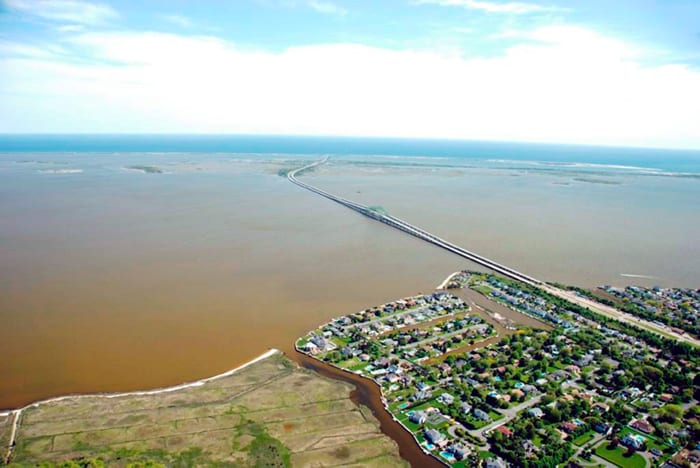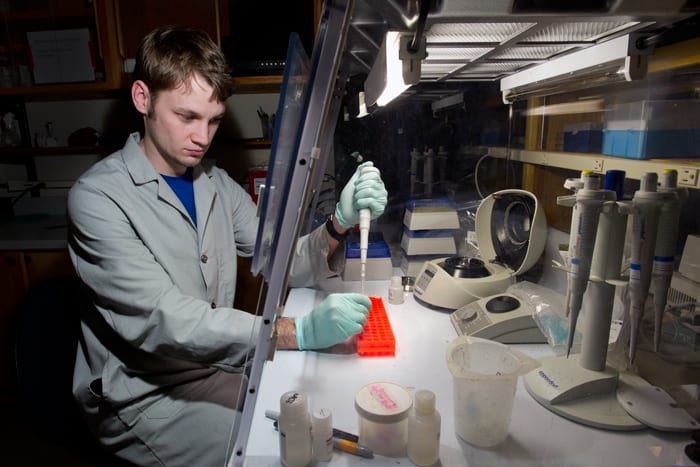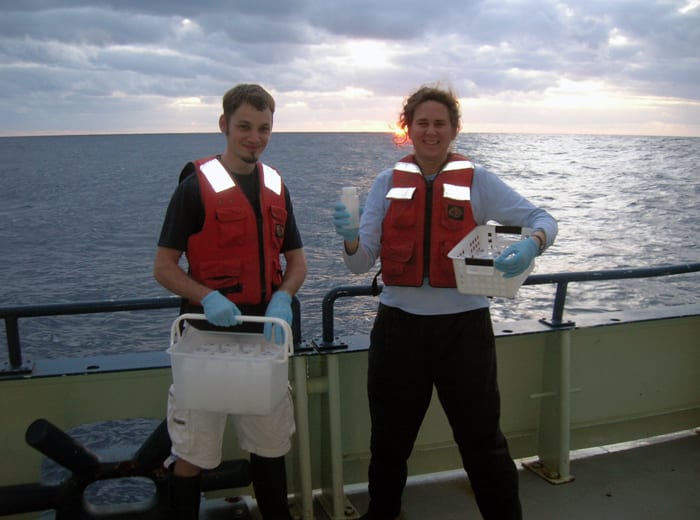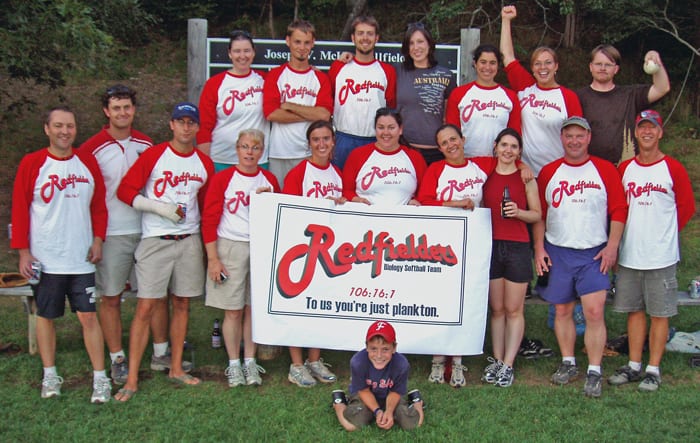
Brown Tides and Redfielders
Scientists probe the inner workings of harmful algae
Come spring, Louie Wurch’s mind turns toward softball and another, less idyllic seasonal phenomenon: brown tides.
Both scientist and shortstop, Wurch spearheaded the creation of the Biology Department’s team in the Woods Hole Oceanographic Institution (WHOI) softball league. They are known as the Redfielders, after the Redfield Laboratory, which in turn is named after Alfred Redfield, an early WHOI biologist renowned for his pioneering research on phytoplankton. These single-celled marine plants also happen to be the focus of Wurch’s research.
Phytoplankton are like the grass of the sea, providing the foundation for the ocean’s food web as well as about half the oxygen in Earth’s atmosphere. The same warm temperatures and sunlight that bring biologists out onto the baseball diamond also stimulate phytoplankton to bloom in the ocean.
“But not all phytoplankton are good,” said Wurch, who earned his Ph.D. in the MIT/WHOI Joint Program in Oceanography in 2011 under the supervision of WHOI biologist Sonya Dyhrman and stayed on in her lab as a postdoctoral scientist. Some marine algal blooms, often called red tides, produce toxins that accumulate in shellfish and cause illness in people who eat them. Then there are brown tides caused by algae like the one Wurch studies, Aureococcus anophagefferens. In estuaries on the U.S. East Coast, these algae can reproduce so rapidly and densely they overwhelm the ecosystem, turning the waters brown, blocking out sunlight, and killing sea grass and the juvenile shellfish that live there.
“Compared to a toxic red tide, a brown tide can actually be worse for local economies,” Wurch said. “You can’t eat shellfish while a red tide is occurring, but it doesn’t kill the shellfish. Once a red tide’s over, the shellfish will filter out the toxin, and they’ll be edible again. If you eat shellfish in a brown tide, you’re not going to get hurt. But brown tides severely alter and degrade the ecosystem and keep baby shellfish from surviving. If you have a brown tide bloom two to three seasons in a row, nothing’s replacing the adult shellfish population. These adults only have life spans of a few years, so recurrent blooms have completely wiped out entire shellfish populations.”
Brown tides have caused collapses of the shellfish industry around Long Island, N.Y., at a loss of millions of dollars each year. What causes them? Why are they becoming more frequent? What can we do to prevent them or mitigate their damage?
To answer those questions, scientists need to understand what’s going on—not only in the estuaries, but also within the algae themselves. To do that, Wurch has taken advantage of rapidly developing techniques to peer into the molecular workings of algae’s DNA, RNA, and proteins under changing environmental conditions.
’Ome-ing in on answers
Just like plants in gardens and lawns, phytoplankton need nitrogen and phosphorus to grow. These nutrients are often scarce in the ocean, but rising human populations and development along the coast have increased fertilizer and sewage runoff, adding excess nitrogen and phosphorus to coastal waters.
In 2007, a team headed by plankton ecologist Chris Gobler at Stony Brook, New York, sequenced the A. anophagefferens genome, its entire set of genes. It was the first species of harmful algae ever sequenced, and Wurch compared the alga’s genes to those of other organisms. But Wurch needed to know not only what genes the brown-tide algae cells have, but also which ones they employ in particular situations.
“The genome is the toolbox,” he said. “Different species have different sets of tools, and when we look at the genome, we’re looking at every tool the species possesses, which gives us a broad look at what they are potentially able to do. But if you want to look at what they’re actually using, you look at the transcriptome.” A transcriptome is the set of all messenger RNA molecules that have been transcribed, or copied, from genes to set in motion the process of manufacturing proteins.
“If you’re a mechanic, you have a set of tools, but you’re not going to use all those tools for every job,” Wurch said. “You’re going to use different tools for changing a tire, for example, than to fix a carburetor. Algae are not using all their tools at the same time. But in the lab, we can create a very specific environment and ask what tools they are using in that environment.”
First, he cultured algal cells in the lab, supplying nitrogen and phosphorus.
“Then we took away nitrogen from them and asked: ‘What is their strategy for dealing with not getting enough nitrogen?’ ” he said. “Then we took away phosphorus from cultures and asked: ‘What genes are they using, what is their strategy?’ ”
Wurch extracted the messenger RNAs and matched them back to their genes—in this way identifying the exact genes the algae activated to cope with low nutrients. The research revealed that A. anophagefferens had genes that allow it to create proteins that transport organic forms of nitrogen and phosphorus into the cell. Most phytoplankton generally prefer and rely on inorganic forms of these nutrients.
This helps explain how brown-tide algae can outcompete other phytoplankton and overwhelm an ecosystem, he said. It also suggests why brown tides have become more prevalent: Outflow from sewers and septic systems is increasing, and it is rich in organic forms of nitrogen and phosphorus.
Simulating a bloom
To probe further, Wurch explored the RNA and proteins produced by the activated genes. He repeated his experiments, first taking away phosphorus. This activated genes that make the proteins that are involved with phosphate scavenging (scavenging is a term used to mean phytoplankton cells obtaining scarce nutrients from their environment). Then he re-supplied phosphorus, removing cells’ need to activate those genes, and examined how quickly the messenger RNA and protein levels declined. Stopping the experiment at various time intervals, he found that the messenger RNA disappeared a few hours after phosphorus was re-supplied, but the proteins persisted for 24 hours.
“So if I go into the environment now and find the messenger RNA for these phosphate scavenging genes for A. anophagefferens, that tells me something different than if I see the proteins produced from this messenger RNA,” Wurch said. The former might indicate that A. anophagefferens is deficient in phosphorus right now, while the latter might indicate a longer timescale of phosphorus deficiency, including both a cell’s current state and a prior history of phosphorous deficiency during the bloom.
“We can literally just ask the cells!” he said. “It’s really exciting, it’s just incredible how much the technology has changed in the short time I’ve been in graduate school. We couldn’t do this when I entered in 2006.”
All this painstaking lab work was the core of Wurch’s Ph.D. research. Working with Dyhrman, he created molecular markers—genes, RNA, and proteins—that they can take into the field to reveal the intricacies of what’s going on during brown tides.
“I’m looking for these molecular markers in water samples from pre-bloom conditions, as the bloom ramps up, in the peak bloom, and as the bloom is declining,” he said. “We can tell what all A. anophagefferens’s genes are doing. We can look at all its RNA molecules in the estuary throughout a bloom cycle, and we can say what’s going on in the environment at each point in time.”
Such information will hold keys to figuring out ways to mitigate brown-tide blooms, he said.
Go, Redfielders, go
Growing up in California, Wurch studied science in college, at first thinking about becoming a veterinarian before switching to marine biology. Then he took a genetics class with a professor who changed his life.
“He asked me, ‘What’s your major?’ “ Wurch said. “I said marine biology, and he just looked at me and said, ‘That’s it?’ Then he said something like, ‘You need to set yourself apart from everyone else with a Marine Biology degree. You have talent, you should add molecular biology as a second major.’ It was the best thing I ever did. Those molecular skills helped me get an undergraduate Summer Student Fellowship at WHOI with Sonya Dyhrman.”
“When I first came to WHOI in 2004, I played in the WHOI softball league,” Wurch said. “That was really my first time playing softball. At that time, the Biology and Applied Ocean Physics and Engineering Departments had a combined team because Bio didn’t have enough players. I really enjoyed it that summer. When I came here in 2006 for graduate school, Biology didn’t have a team at all.”
He contacted the WHOI league’s organizer “and told him that I wanted to try and recruit enough people so that Biology could have its own team.” Thus began the Redfielders, whose roster now overflows with biologists who take their recreation seriously. Unlike most teams in the league, they sport eye black (as much for fun as sun glare) and T-shirts emblazoned with the team’s name.
When it came time for Wurch to deliver his thesis defense in 2011, his teammates backed him up.
“I was incredibly nervous,” he said. “I thought I wouldn’t be able to get up and do it. I looked out at the audience, and there was Ed DeLong from my committee—a National Academy of Sciences member. Then, my mom. Then, there were 30 people in eye black and Redfielder shirts!”
Wurch continued to coach the Redfielders for his seventh and final season. He will soon take a postdoctoral position at Oak Ridge National Laboratory in Tennessee. He’s already checked out the softball league there and met the coach.
His last game as the Redfielders’ captain is Wednesday, against the team from the WHOI Geology and Geophysics Department.
“Someone’s got to take over,” he says. “Somebody has to step up!”
This research was funded by the National Oceanic and Atmospheric Administration’s ECOHAB program, the National Science Foundation, the Environmental Protection Agency STAR Research Assistance Agreement, the Adelaide and Charles Link Foundation, and the WHOI Coastal Ocean Institute.
From the Series
Slideshow

Slideshow
- The brown tides caused by the alga Aureococcus anophagefferens—like this one in Long Island, N.Y.—do not produce toxins that poison humans, but the long-lasting blooms damage sea grass beds and shellfisheries and lead to economic losses of millions of dollars annually. (Christopher Gobler, Stony Brook University School of Marine and Atmospheric Sciences)
- Louie Wurch extracts RNA from Aureococcus anophagefferens in Sonya Dyhrman's Phytoplankton and Marine Biogeochemistry Laboratory at WHOI. A research team including Wurch found that the harmful algal bloom species has a unique gene complement that allows it to outcompete other marine phytoplankton and thrive in ecosystems that have been changed by human activities. (Tom Kleindinst, Woods Hole Oceanographic Institution)
- Aboard the research vessel Oceanus in the Atlantic Ocean, graduate student Louie Wurch and his advisor, phytoplankton ecologist Sonya Dyhrman, hold samples of seawater containing single-celled algae. (Ben Van Mooy, Woods Hole Oceanographic Institution)
- The Redfielders, proud softball team of the WHOI Biology Department, came into being through the efforts of Louie Wurch (second row, second from left). With a motto of, "To us, you're plankton," the team was named for WHOI's Redfield building, which was itself named after a renowned biologist who discoveredthe Redfield ration: the near-universal 106:16:1 ratio of the elements carbon to nitrogen to phosphorous found in plankton. (Courtesy of The Redfielders)
Related Articles
- Are warming Alaskan Arctic waters a new toxic algal hotspot?
- The Living Breathing Ocean
- Forecasting Where Ocean Life Thrives
- PlankZooka & SUPR-REMUS
- Illuminating an Unexplored Undersea Universe
- Specks in the Spectrometer
- Setting a Watchman for Harmful Algal Blooms
- Short-circuiting the Biological Pump
- A Telescope to Peer into the Vast Ocean
Featured Researchers
See Also
- First Harmful Algal Bloom Species Genome Sequenced WHOI news release, February 2011
- MIT/WHOI Joint Program in Oceanography/Applied Ocean Science & Engineering



